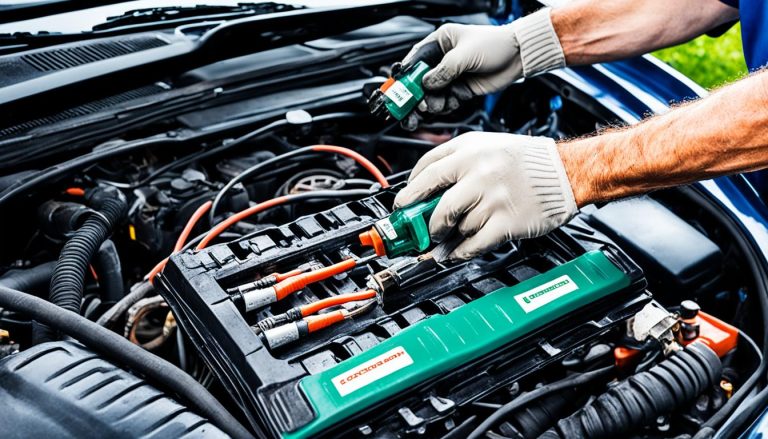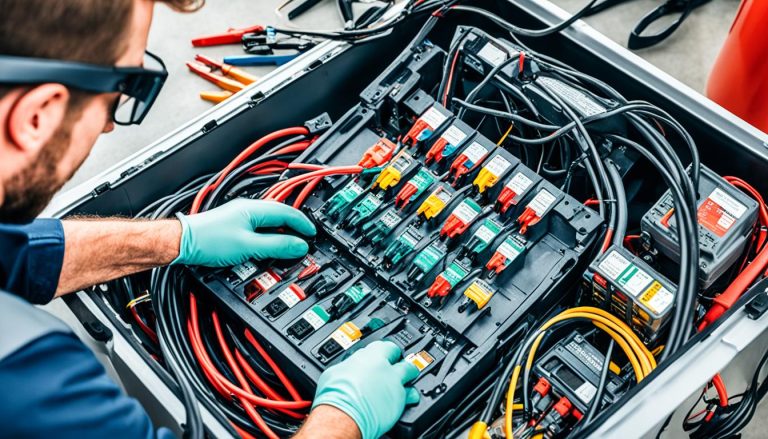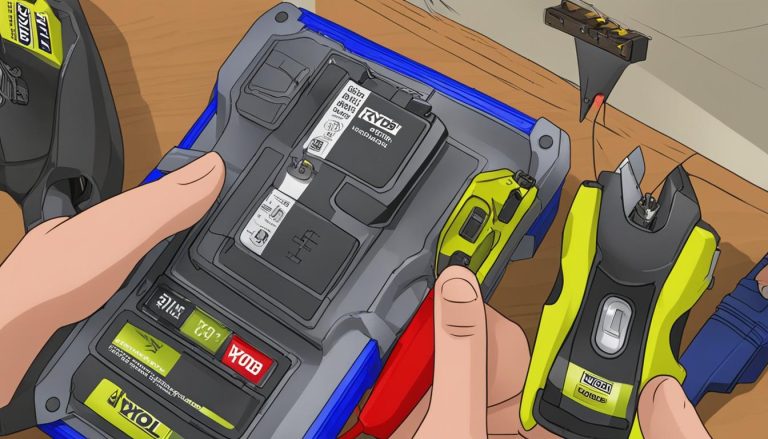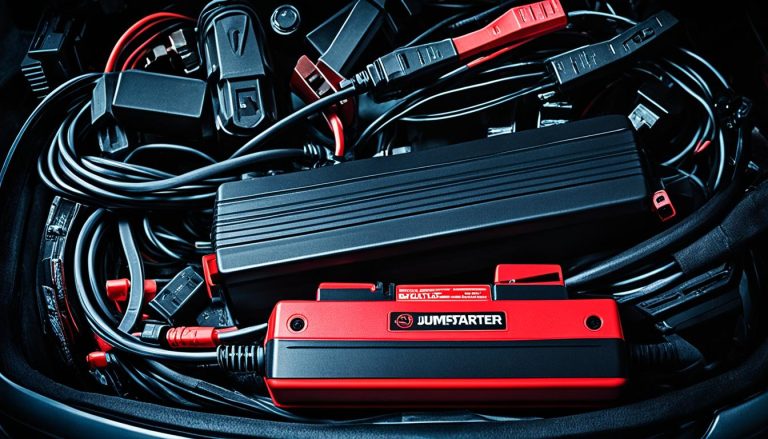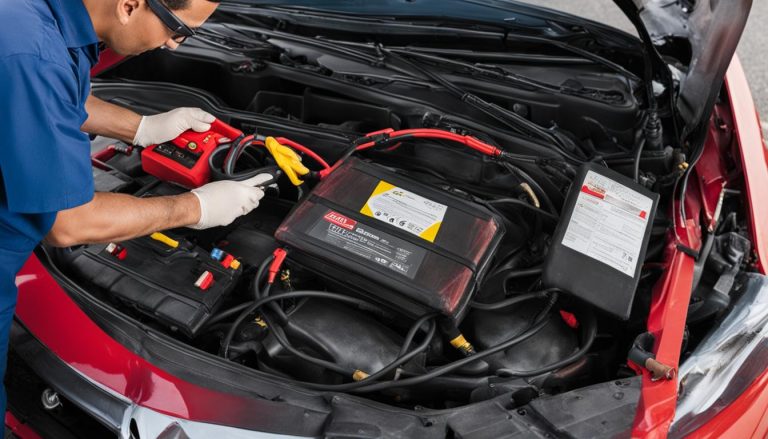Jump Start a Dead Battery – Best Way Explained
batterychargers.site and its partners may earn a commission if you purchase a product through one of our links
Have you ever walked up to your car, turned the key, and found yourself facing the dreaded silence of a dead battery? It’s a common scenario that can disrupt your day. But fear not, learning the best way to jump start a dead battery can have you back on the road in no time. With this guide, you’ll discover the smart and safe techniques to effectively perform a dead battery jump start. Equip yourself with the knowledge of how to jump start a car battery and take control the next time your vehicle won’t start. Whether it’s ensuring proper cable connections or learning the subtle cues of a battery’s demise, you can master the art of jump starting a car with confidence.
Understanding the correct procedures not only saves time but also guards against potential hazards. One can never be too prepared when it comes to dealing with automotive troubles. This information is essential, whether it’s an emergency situation or helping out a fellow driver. So let’s dive into the essential steps and precautions to effectively carry out a car battery jump start and get you powered up and ready to roll!
Key Takeaways
- Recognizing the signs of a dead battery is critical in preventing unexpected vehicle downtime.
- Understanding how to properly connect jumper cables is essential for a safe and successful jump start.
- Knowledge of using another vehicle or a power box as a power source can make jump starting smoother.
- Remembering to drive your vehicle after jump starting aids in recharging the battery.
- Being aware of common jump start mistakes helps avoid damage to your car and ensures safety.
Understanding the Basics of a Dead Battery
When you turn the key and are met with silence or that dreaded clicking sound, you’re likely facing a dead battery. Knowing the basics behind battery failure is essential for addressing the problem swiftly and efficiently. Let’s delve into the common culprits of battery drain, familiarize ourselves with dead car battery symptoms, and understand the significance of car battery voltage in your vehicle’s health.
What Causes a Car Battery to Die?
Several reasons for battery drain can catch any driver off guard. Frequently, it’s the simple things; leaving your headlights on overnight or using the car’s electronics without the engine running can sap your battery’s life. However, it could also be a sign of something more innate, like a battery reaching the end of its life span, or even a more complex electrical issue that requires professional diagnosis.
Signs You’re Dealing With a Dead Battery
Recognizing the signs of a dead battery can save you from being stranded. Dead car battery symptoms include the inability to start your car, a slow cranking engine on startup, and dimming of your interior and dashboard lights. Even your car’s responsive accessories, like power windows, may operate sluggishly suggesting the battery isn’t holding a charge.
The Role of Voltage in Car Batteries
Car battery voltage is the linchpin of effective automotive performance. A healthy battery should typically read 12.6 volts or higher when the vehicle is off. Anything lower is a clear indication of a weak battery, potentially unable to muster the power to start your vehicle. Regular voltage checks can prevent unexpected battery failures and ensure your car remains reliable.
Remember, durability and maintenance of a battery can influence its lifespan. Regularly test your battery’s voltage and look out for early warning signs to avoid the inconvenience of a dead battery.
Preparing to Jump Start Your Car
Before attempting to revive your vehicle with a jump start, it’s crucial to have the right car jump start tools at your disposal. Securing the essentials for jump starting will not only streamline the process but also ensure safety and effectiveness. Jumper cables selection plays a significant role in the success of this operation, along with finding a reliable power source for jump start.
Essential Tools for Jump Starting a Car Battery
Ensuring you have a quality set of jumper cables, a fully charged power box, or a secondary vehicle with a compatible battery are the foundations of a successful jump start. Safety gloves and eye protection are also advisable to guard against potential sparks or battery acid.
Choosing the Right Jumper Cables
When selecting jumper cables, look for ones with thick wires and sturdy, well-insulated clamps that can withstand the amperage. The cable length is also important – usually, a length of about 10 to 20 feet is adequate to span the distance between two vehicles.
Finding a Power Source: Another Vehicle or a Power Box
Identify a power source: either another vehicle with a working battery or a portable jump starter. If you’re using another car, ensure both vehicles have a similar voltage to prevent damage to the electrical systems. Portable power boxes are a convenient alternative as they are capable of jump starting without the need for a secondary vehicle.

| Tool Type | Features | Usage Consideration |
|---|---|---|
| Jumper Cables | Thick gauge, insulated clamps, minimum 10 ft. length | Select with sufficient length and current capacity |
| Portable Power Box | Built-in charger, various amperage options | Choose one with enough power to start your vehicle |
| Safety Gear | Insulating gloves, eye protection | Wear to protect against accidental sparks or battery acid |
| Secondary Vehicle | Requires matching voltage and functional battery | Ensure the assisting vehicle has a fully charged battery |
Best Way to Jump Start a Dead Battery
When faced with the task of jump starting a car battery safely, a bit of knowledge and a cautious approach can make all the difference. Here are some easy ways to jump start a dead battery and valuable tips for jump starting a dead battery without risking damage to your vehicle or injury to yourself.

To ensure success, park the operational vehicle close to, but not touching, the one with the dead battery. Make certain that both vehicles are turned off to avoid any electrical surges or sparking. The proper connection of jumper cables is crucial:
- Attach one red clamp to the positive (+) terminal of the dead battery.
- Connect the other red clamp to the positive (+) terminal of the good battery.
- Affix one black clamp to the negative (-) terminal of the good battery.
- Finally, fasten the last black clamp to an unpainted metal surface on the engine block of the car with the dead battery. This grounds the circuit and enhances safety.
With the jumper cables securely connected, start the engine of the vehicle with the good battery. Allow it to run for a few minutes—this can help build charge in the weakened battery, increasing the chances of a successful start. Then attempt to start your car with the dead battery. If it doesn’t start right away, give it a few more minutes and try again.
Remember to disconnect the jumper cables in the reverse order you connected them, and don’t let the clamps touch each other or any metal surfaces during this process. Once your car is running, it’s recommended to keep it active for at least 15 minutes to help recharge the battery.
Understanding these tips for jump starting a dead battery not only helps in emergencies but also ensures the longevity of your battery’s life. Now that you’re equipped with knowledge, you can feel confident in handling one of the most common car troubles faced by drivers today.
Step-by-Step Guide to Jump Starting a Dead Battery
Reviving a dead car battery can be a daunting task, but with the right guidance, you can get back on the road in no time. Understanding the car jump starting process is essential to ensure safe jump starting. So, roll up your sleeves, and let’s walk through the practical steps to jump start a dead battery effectively.
Safety First: Proper Precautions Before You Start
Before you begin, prioritize your safety and that of those around you. Clear the area of any children or pets, and make sure to unplug accessories from the cigarette lighter or USB ports to prevent potential electrical issues. It’s crucial to wear protective gear such as safety glasses and gloves, as batteries contain corrosive acid that can be hazardous.
Connecting the Jumper Cables: The Correct Order
It’s imperative to connect the jumper cables in the proper sequence to prevent electrical shorts and sparks. Begin by clamping the red cable to the positive terminal of the dead battery. Then, attach the other red clamp to the positive terminal of the live battery. After securing the red cables, connect the black cable to the negative terminal of the good battery. The final step involves attaching the remaining black clamp to an unpainted metal part of the car with the dead battery—this acts as a ground. See the included image to help visualize the setup.
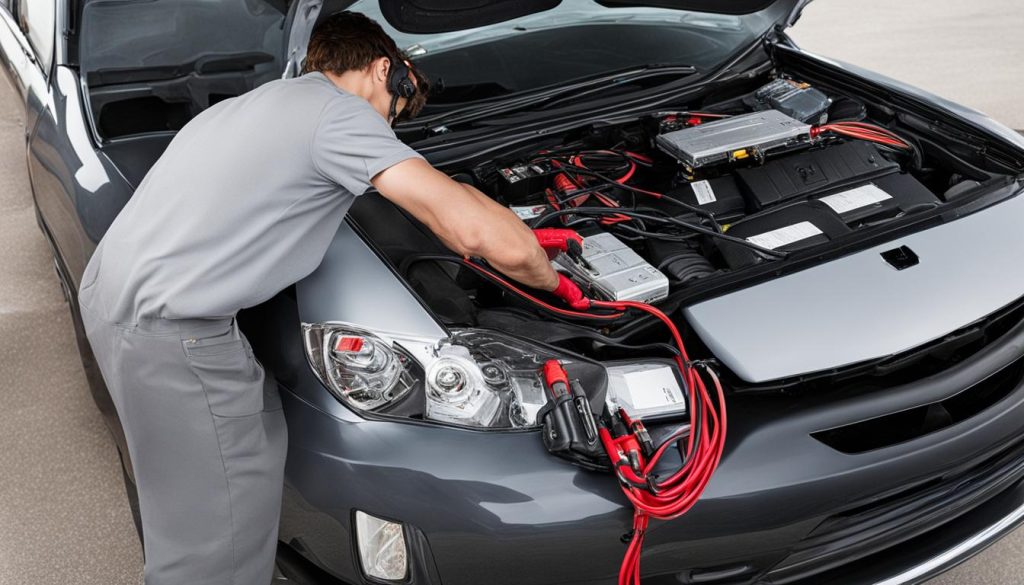
Jump Starting Procedure: Turning Over the Engine
Once everything is hooked up correctly, start the engine of the car with the good battery first. Let it idle for a few minutes to allow the alternator to charge the dead battery. After a short while, attempt to start the car with the dead battery. If it doesn’t turn over immediately, don’t worry. Let the donor car run a little longer and try again. Patience is key to avoiding damage to either car’s electrical systems.
| Activity | Description | Duration |
|---|---|---|
| Attach positive clamp (Red) | Dead battery’s positive terminal | |
| Attach positive clamp (Red) | Good battery’s positive terminal | |
| Attach negative clamp (Black) | Good battery’s negative terminal | |
| Ground negative clamp (Black) | Unpainted metal surface on the dead battery’s car | |
| Start donor car | Run donor car to charge dead battery | Several minutes |
| Attempt to start dead car | If first attempt fails, run donor car longer and try again | Varies |
Following these methodical steps will boost your confidence in handling a dead battery and ensure you’re prepared in case of future occurrences. Remember, proper technique and safety measures are critical for a successful jump start. Happy driving!
Post-Jump: Keeping Your Battery Healthy
Successfully reviving your car with a jump start is just the first step towards a reliable ride. To avert future failures and maintain your vehicle’s electrical health, it’s important to follow up with proper car battery maintenance. By understanding the implications of driving after jump start and recognizing dead battery warning signs, you can save yourself the inconvenience and cost of untimely battery replacements.
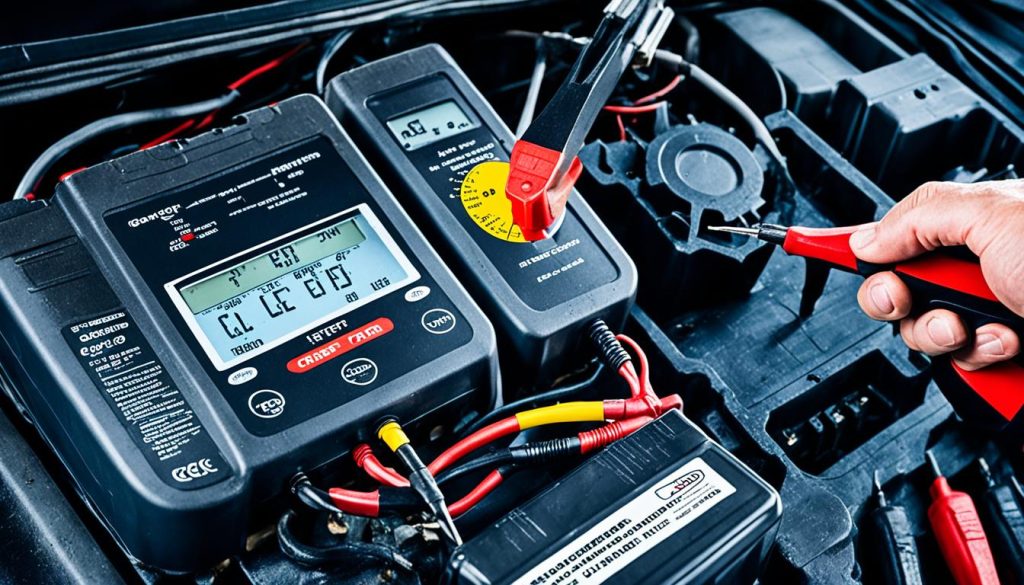
The Importance of Driving After Jump Starting
Once your vehicle is running again, it’s not time to turn off the engine just yet. Your battery needs more than just a kick-start; it needs to recharge. Driving after jump start for at least 15-30 minutes without stopping will help your alternator charge the battery and restore your car’s full starting power. This vital step is not just a good suggestion—it’s a cornerstone of post-jump battery rejuvenation.
Maintaining Battery Health: Tips and Tricks
Maintaining your car battery is instrumental in ensuring longevity and reliability. Regular checks should be a part of your routine. The basics include:
- Cleaning the terminals to prevent corrosion
- Ensuring that the connections are tight and secure
- Checking the battery case for any signs of damage or unusual bulging
- Verifying that your car’s charging system is putting out the correct voltage (typically around 13.7 to 14.7 volts while running)
These small acts of diligence can significantly curb the risks of unexpected battery failures.
Warning Signs to Watch Post Jump Start
Vigilance after a jump start is crucial for catching any lingering issues that may not have been resolved. Early detection is key, so keep your senses sharpened for these dead battery warning signs:
- Difficulty in starting the engine, particularly if this occurs repeatedly
- Electrical components acting erratically, such as flickering lights or defective accessory outputs
- A dashboard battery light that remains illuminated while driving
Facing these symptoms might point toward the need for a thorough diagnostic check or potentially a battery replacement. Ignoring such warnings will only lead to further vehicle stress and, eventually, immobility.
Road safety and vehicle maintenance go hand in hand. By applying these essential measures for car battery upkeep, you’re not just caring for your car—you’re ensuring peace of mind on every journey.
Common Mistakes to Avoid When Jump Starting
Jump starting your car seems straightforward, but even the seemingly smallest of missteps can lead to significant problems. Ensuring your safety and preserving the integrity of your vehicle’s electrical system hinge on your knowledge of proper procedures and your ability to sidestep common pitfalls.
Neglecting Safety Procedures Can Lead to Harm
To begin with, jump start safety tips are not just for protocol; they are essential to your well-being. Skipping basic safety measures, such as wearing protective eyewear, keeping sparks away from the battery, and ensuring that the cars do not touch, can expose you to a high risk of injury.
Risks of Using Damaged Equipment
Using damaged jumper cables is a risky oversight. If they’re showing signs of wear such as rust or frayed wires, the damaged jumper cables risk damaging the electrical systems of both cars or may even compromise your safety. Always inspect your cables before use.
Consequences of Incorrect Cable Connections
One common yet dangerous misstep is incorrect cable placement. The consequences of wrong cable connections can be severe, ranging from electric shocks to the possibility of an electrical fire. Always double-check that you’re connecting the right leads to the corresponding battery terminals.
Besides understanding these precautions, it’s vital to grasp the specifics of jump starting to prevent common mistakes. Below is a comprehensive breakdown of do’s and don’ts when jump starting your vehicle:
| Do’s | Don’ts |
|---|---|
| Wear protective gear. | Use jumper cables on mismatched voltage systems. |
| Check that both vehicles are turned off before connecting cables. | Allow metal parts of the clips to touch each other. |
| Connect red to positive (+) and black to negative (-). | Smoke or work near flammable liquids while operating. |
| Keep a fire extinguisher nearby. | Ignore warning signs such as smoke or sparks. |
| Follow the vehicle’s manufacturer guidelines. | Attempt to jump start if the battery is damaged or leaking. |
Remember, when it comes to jump starting, patience and attentiveness are as important as technical know-how. By avoiding these common mistakes and following the listed safety practices, you’ll ensure a safe and successful jump start.
What to Do When Jump Starting Fails
Experiencing a battery jump start fail can be a puzzling scenario. It’s important to understand that when your car won’t jump start, it often points to underlying issues that require troubleshooting jump start issues. Let’s walk through some steps you can take to diagnose the problem.
If you’ve tried and failed to jump start your car, the first step is not to panic. Several components could cause the failure, and some can be checked quickly. Your battery may not be the only culprit; the problem could also lie with the alternator, starter motor, or other electrical system components.
Before proceeding, ensure your jumper cables are properly connected, the cables are free of damage, and neither car has an electronic issue that could interfere with the jump starting process. Once you’ve ruled out the simple fixes, consider the following troubleshooting table:
| Potential Issue | Symptom | Troubleshooting Action |
|---|---|---|
| Dead battery | Car does not start at all | Check battery voltage, inspect for acid leaks and corrosion |
| Faulty alternator | Battery charge doesn’t last | Test alternator output with a multimeter |
| Defective starter | Clicking noise when trying to start | Inspect starter circuit, relay, and solenoid |
| Electrical drain | Battery dies quickly while car is off | Conduct a parasitic drain test |
| Corroded connections | Poor electrical flow | Clean battery terminals, check for loose wires |
If the issue persists after your own diagnosis, it’s time to consult a professional. A certified technician can offer a more in-depth analysis using specialized diagnostic equipment. Remember, the goal is not just to get your car started, but to ensure it stays running reliably for your safety and convenience.
Your local dealership may also provide additional support, especially if your car requires brand-specific troubleshooting or software resets. There’s no shame in asking for help; sometimes, the professional touch is exactly what your vehicle needs to get back on the road.
Alternative Solutions for a Dead Battery
If your car’s battery has taken its final bow and refuses to be revived through jump-starting, don’t worry—there are still options available to get you back on the road. Exploring alternative jump start methods can save you time and hassle. In situations where traditional jump-start attempts fall short, being informed about alternative approaches is crucial to navigate your next move efficiently.
Battery Packs: Portable Jump Starting Options
One of the most convenient tools at your disposal is portable battery jump-starters. These compact devices can be a real lifesaver, allowing you to start your vehicle without the need for another car. They come in various sizes, with some even fitting into your glove compartment. It’s vital to choose one that fits your vehicle’s requirements—usually measured in amps. Keep in mind that while portable battery jump-starters are excellent in a pinch, they must be regularly charged to ensure readiness.
Professional Assistance: When to Call for Help
Sometimes, the situation calls for reinforcements. If you’re uncertain about using a jump starter or if repeated attempts have been unsuccessful, professional roadside assistance may be your best bet. Services like AAA are known for reliability and can provide rapid help when you’re stranded. When your battery’s condition is beyond a simple jump or replacement, these professionals are equipped to tow your vehicle to an authorized service center for further diagnostics and repair.
Mechanic Valet & Pickup/Drop-off Services Explained
For a more effortless experience, consider utilizing mechanic valet services. These services not only jump-start or replace your car’s dead battery but also offer the convenience of picking up and dropping off your vehicle once it’s ready. This can be especially useful if you have a busy schedule and can’t afford to wait for service or tow your car to the shop. While this option might come with added costs, the convenience and peace of mind can be worth the investment. Remember to choose a reputable service to ensure your car is in good hands.
FAQ
What Causes a Car Battery to Die?
A car battery can die from numerous causes, including leaving the headlights on, using accessories while the engine is off, extreme temperatures, old age of the battery, or an underlying electrical problem within the vehicle.
Signs You’re Dealing With a Dead Battery?
The most common signs are the car not starting, dim lights, electrical issues, and the dashboard battery light illuminating. You might also notice a slow cranking sound when attempting to start the engine.
The Role of Voltage in Car Batteries?
Voltage is crucial for a car battery’s operation. A healthy, fully charged car battery should typically show about 12.6 volts or above. A reading below this could indicate a weak or undercharged battery.
Essential Tools for Jump Starting a Car Battery?
The essential tools for jump starting include a set of high-quality jumper cables and a power source, such as another vehicle with a working battery or a portable jump starter.
Choosing the Right Jumper Cables?
You should choose jumper cables that are at least 8 to 10-feet long, gauge 6 or thicker. Check for sturdy clamps and any signs of wear, damage, or corrosion before use.
Finding a Power Source: Another Vehicle or a Power Box?
A power source can either be another vehicle with a functioning battery of similar voltage or a portable jump box. Ensure the helper car or jump box has enough power to start your vehicle.
Easy Ways to Jump Start a Dead Battery?
To easily jump start a dead battery, park the working vehicle close by, ensure both vehicles are off, connect the positive jumper cable ends to both positive battery posts, and the negative cable to the working battery’s negative post and an unpainted metal surface on your vehicle. Start the donor vehicle, then try starting your car.
Safety First: Proper Precautions Before You Start?
Proper precautions include ensuring the vehicles don’t touch each other, turning off both vehicles, removing jewelry that could catch on components, and never connecting the negative cable directly to the dead battery’s negative post to avoid sparks.
Connecting the Jumper Cables: The Correct Order?
Connect the red, positive cable clamp to the dead battery’s positive post first. Then connect the other red clamp to the donor battery’s positive post. Attach the black, negative cable to the donor battery’s negative post, and then connect the other black clamp to an unpainted metal part on your vehicle.
Jump Starting Procedure: Turning Over the Engine?
After connecting the cables in the proper order, start the donor vehicle and let it run for a few minutes. Then attempt to start your vehicle. If it doesn’t start, wait a few more minutes and try again.
The Importance of Driving After Jump Starting?
Driving your vehicle for at least 15-30 minutes after jump starting allows the battery to recharge. This helps restore its charge and ensures the vehicle will start again later.
Maintaining Battery Health: Tips and Tricks?
To maintain your battery’s health, keep the terminals clean, ensure they’re properly tightened, avoid short trips that prevent full charging, and get routine battery checks as part of vehicle maintenance.
Warning Signs to Watch Post Jump Start?
Post jump start, watch for signs such as difficulty starting the vehicle, dimming lights, and electrical issues. These can indicate that your battery hasn’t fully recovered and may need further attention.
Neglecting Safety Procedures Can Lead to Harm?
Yes, neglecting safety procedures can result in injury from electrical shock, battery explosion, or sparks that could cause a fire. Always follow the correct order and safety measures when jump starting a battery.
Risks of Using Damaged Equipment?
Using damaged jumper cables or a power source can lead to an ineffective jump start, electrical short-circuiting, vehicle damage, and personal injury.
Consequences of Incorrect Cable Connections?
Incorrect cable connections can cause electrical issues that may damage both vehicles, create sparks or even cause a battery to explode. Always ensure the cables are connected in the correct order.
What to Do When Jump Starting Fails?
If jump starting fails, it might indicate a more serious problem such as a faulty alternator or starter. In this case, it is advisable to contact a professional mechanic for a thorough diagnosis and repair.
Battery Packs: Portable Jump Starting Options?
Portable battery packs are compact devices that can jump start your vehicle without another car. They’re convenient to carry in your vehicle and use in emergencies.
Professional Assistance: When to Call for Help?
Call for professional assistance if jump starting doesn’t work, if you’re unsure about the process, or if you suspect your car has electrical problems that require expert diagnosis.
Mechanic Valet & Pickup/Drop-off Services Explained?
Mechanic valet and pickup/drop-off services are convenient options whereby your car is collected, repaired or serviced for its battery issues, and then returned to you ready for use.


